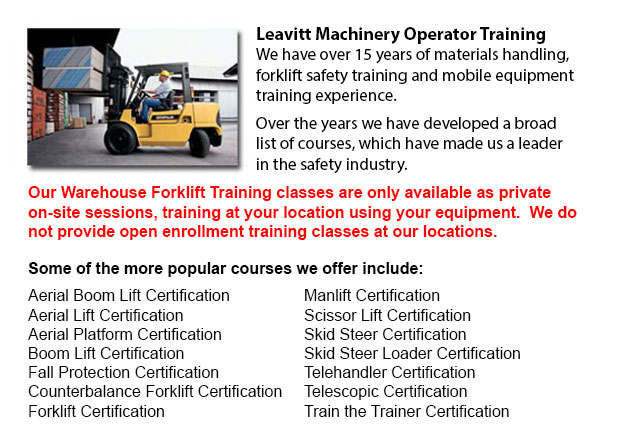
Warehouse Forklift Training Programs Goodyear - Warehouses could be industrial, commercial or retail facilities. Their function can vary from product distribution to retailing bulk products. Regardless of the kind of warehouse, employees within warehouse settings must be well trained in safety procedures related to material storage and handling, loading docks, conveyor systems, and forklifts and pallet jacks. Good housekeeping is important to an orderly and safe warehouse setting.
The loading dock system is often build into the warehouse at a height from the ground making it easy to move stuff moving out and coming in of the warehouse. Personnel would also load and unload materials and merchandise from the ramps and elevated docks. Particular attention should be paid to safety habits throughout this stage. In order to prevent falls, install yellow striping along the edge of docks and ramps. Pay attention to the area around delivery trucks that are parked at the loading dock, particularly the area between truck and dock. Be certain that truck wheels are chocked when unloading.
Some warehouses make use of conveyor systems to distribute products in the facility. Conveyor systems have moving wheels and belts which pose a pinch point hazard. Keep hair and parts of the body well away from conveyors to prevent injury. Elevated conveyors pose a danger to personnel underneath if safety nets are absent. Employees should know how to stop conveyors in the event of emergency. Be aware of the location of off switches and emergency stop buttons. When servicing conveyors, lock out/tag out procedures are mandatory.
Forklifts and pallet jacks are designed to move materials around the warehouse. Operators of forklifts are required to take training and be given certification. Operators of pallet jacks do not require certification, but must be trained on the machine. Training courses instruct operators in the right ways for lifting objects and transporting them to their assigned place. Neither pallet jacks nor forklifts should ever be used to lift or transport personnel.
Storage shelving and rack systems help to create an efficient and orderly work area if they are braced, sturdy, and allow sufficient room for individuals and machines to pass. Careful and slow placement of good is needed to avoid accidents caused by products falling off the facing aisle. Aisles must be kept clear by storing products flat and inside the shelving units. Pallets are utilized for stacking products. They should be in good condition, and palleted products must be baled or shrink-wrapped, whenever possible.
PPE or also referred to as personal protective equipment must be worn when needed to help protect the workers' heads, limbs, hands and feet. Hard hats or bump caps, steel-toed shoes and gloves are common PPE.
Slippery floors pocked with dents and pits present a hazard. Good housekeeping habits include keeping warehouse docks and floors clear of debris, oil and dirt. The space should be kept clear of baling supplies, trash and boxes.
-
Crane / Overhead Crane / Truck Mounted Crane / Hydraulic Cranes Training in Goodyear
Bridge cranes or likewise called overhead cranes are a kind of industrial material handling crane making use of a line and hook device that runs on a horizontal beam running along two widely separated rails. Many overhead cranes can be seen inside a... More -
Fantuzzi Parts
The Italian Fantuzzi Group offers a glut of material handling equipment and heavy machinery. The equipment consists of numerous equipment specializing in transporting, loading and unloading goods. The railway freight sector and the port authority req... More -
Forklift Training School Goodyear
Forklift Training School Goodyear - Why A Forklift Training School Could Actually Help A Business And Its Employees - CSA and OSHA establish criteria for forklift safety training that meets existing regulations and standards. Anyone intending to oper... More -
Warehouse Forklift Training Classes Goodyear
Warehouse Forklift Training Classes Goodyear - The purpose of warehouse training classes are to raise the awareness of common workplace hazards. The trainees would learn necessary warehouse safety measures. An emphasis is placed on paying attention t... More -
Aerial Lift Ticket Goodyear
Aerial Lift Ticket Goodyear - A boom truck is frequently recognized by the cable and phone business vehicles that have the long arm folded over their roofs. Usually, a bucket-like apparatus sits at the extension of extendable arms. Sometimes termed a... More -
Telehandler Ticket Goodyear
Telehandler Ticket Goodyear - The telescopic handler or telehandler is a generally used equipment in agricultural and industrial applications. This machine is similar in look to a forklift and even works in a similar way, even though telehandlers are... More -
Scissor Lift Safety Training Goodyear
Scissor Lift Safety Training Goodyear - A Scissor Lift is a practical type of platform that normally moves in a vertical direction. The equipment is capable of this movement because of the use of folding supports that are linked in a criss-cross patt... More -
Aerial Boom Lift Training Goodyear
Aerial Boom Lift Training Goodyear - For individuals who operate or supervise the use of aerial lift platforms, right aerial boom lift Training is necessary. The aerial lift platform is for lifting individuals, materials and tools to elevated work lo... More

Forklift Training Goodyear
TOLL FREE: 1-888-254-6157
Goodyear, Arizona
forkliftcertificationgoodyear.com
Email Us
About Us


